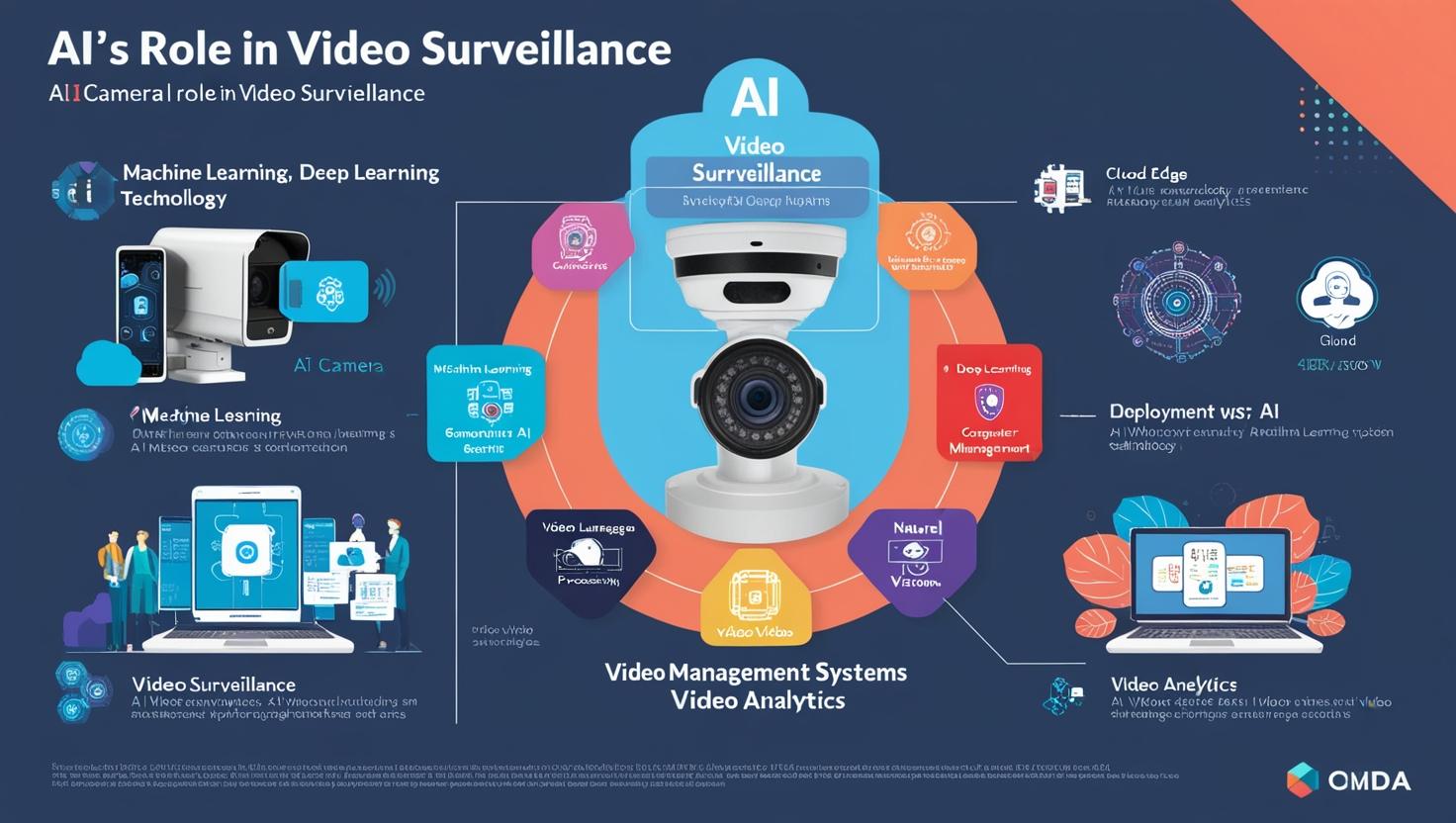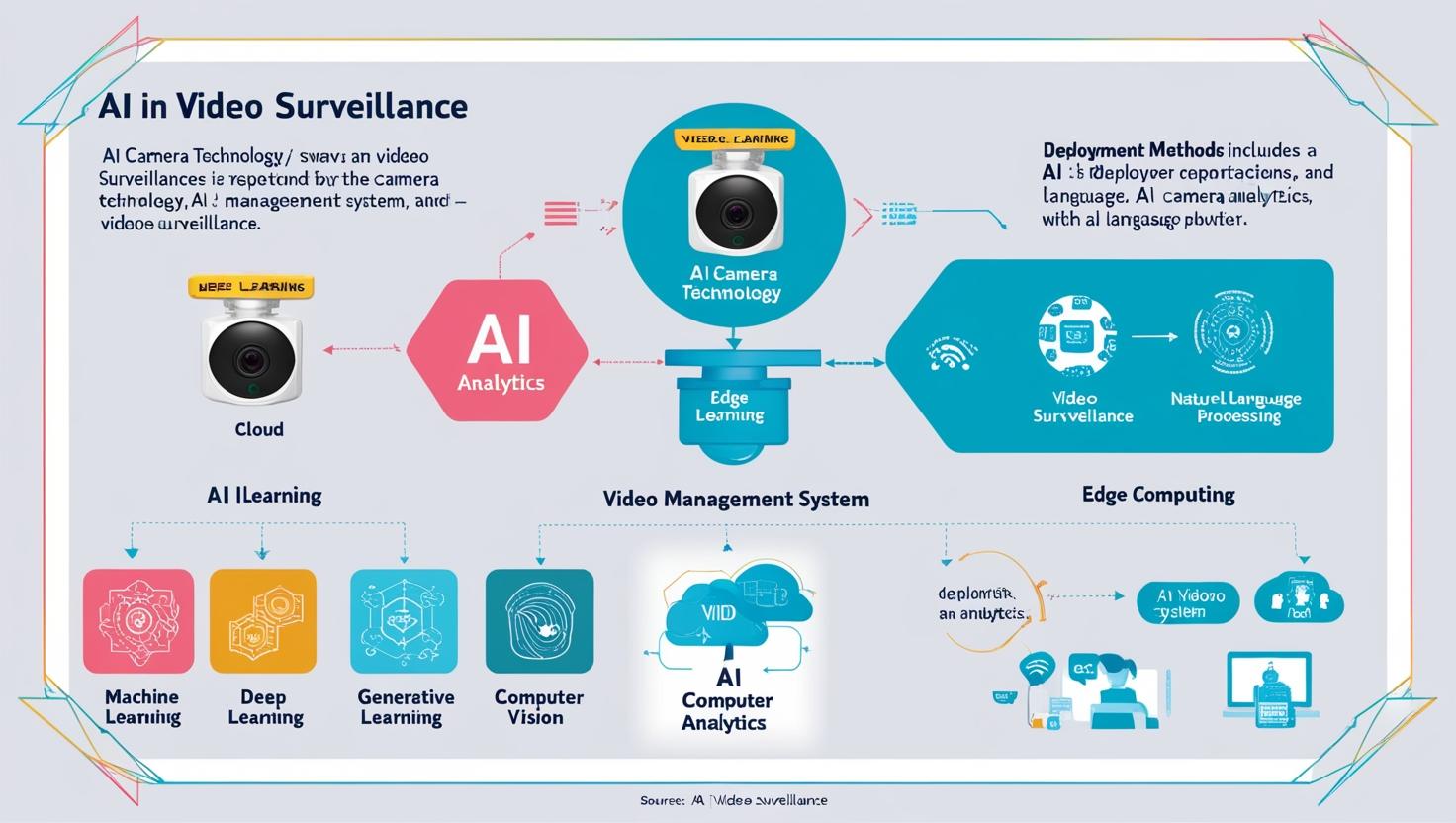The AI in video surveillance market in North America is undergoing a transformative shift, fueled by advancements in artificial intelligence (AI), machine learning (ML), and computer vision technologies. As businesses and institutions face increasing security threats, the demand for smarter, more efficient video surveillance solutions has skyrocketed. AI has emerged as a game-changing technology in the security industry, enabling real-time analysis, predictive insights, and enhanced decision-making. In this article, we will explore the key trends driving the growth of AI in video surveillance in North America and identify the opportunities for businesses and technology providers in this rapidly expanding market.

1. Integration of AI and Advanced Video Analytics
Traditionally, video surveillance systems were limited to recording footage for later review, which often led to delayed responses to security incidents. The introduction of AI-powered video analytics has revolutionized the video surveillance landscape by enabling real-time processing and analysis of video feeds. These advanced analytics allow systems to detect and alert security personnel about suspicious activities, intrusions, or unusual behavior instantly.
Key features driving AI integration in video surveillance include:
- Facial Recognition: AI-enabled facial recognition systems are being adopted across various industries, including retail, finance, and airports, to identify individuals in real-time and enhance security.
- Object and Motion Detection: AI-powered video surveillance systems can track specific objects or movements within a video feed, allowing for targeted monitoring and faster responses.
- Behavioral Analysis: AI can analyze human behavior patterns, identifying potential threats such as aggressive movements or unauthorized access to restricted areas.
This shift from passive surveillance to active, real-time monitoring is one of the most significant trends driving the demand for AI in video surveillance.
2. Increased Focus on Privacy and Compliance
As the use of AI-powered video surveillance systems grows, so does the focus on privacy concerns and regulatory compliance. Organizations must navigate the complex landscape of data protection laws and ensure that their video surveillance systems are compliant with local and international regulations.
In North America, privacy regulations like the General Data Protection Regulation (GDPR) in Europe, and various state-level privacy laws in the U.S., including the California Consumer Privacy Act (CCPA), mandate that businesses handle video data responsibly. With AI algorithms processing vast amounts of sensitive video data, ensuring compliance with these laws has become a priority.
Key privacy and compliance considerations include:
- Data Encryption: Ensuring that all video footage is encrypted both during transmission and at rest.
- Data Anonymization: AI systems that blur faces or anonymize data to protect individual privacy while still providing actionable security insights.
- Regulatory Compliance: Ensuring that AI systems follow the legal frameworks surrounding data usage, storage, and sharing.
Organizations that can demonstrate a commitment to privacy and compliance will be better positioned to capitalize on the growing AI in video surveillance market in North America.
Download PDF Brochure @
https://www.marketsandmarkets.com/pdfdownloadNew.asp?id=84216922
3. Cloud Integration and Remote Monitoring
The increasing adoption of cloud-based video surveillance solutions is another key trend shaping the North American market. Cloud technology enables businesses to store vast amounts of video data securely and access it from anywhere, providing more flexibility and scalability compared to traditional on-premise storage solutions. Additionally, the integration of AI into cloud-based surveillance systems allows for centralized management of security systems across multiple locations.
Benefits of cloud-based AI video surveillance include:
- Cost Efficiency: Cloud solutions eliminate the need for expensive hardware infrastructure, reducing upfront costs and ongoing maintenance.
- Scalability: Businesses can easily scale their surveillance systems as their needs grow without the limitations of physical storage or servers.
- Remote Monitoring: Cloud-based systems allow security personnel to monitor multiple locations remotely, enhancing the flexibility and response time of security operations.
As cloud adoption continues to rise, AI-powered surveillance systems will become increasingly accessible to businesses of all sizes, driving growth in the North American market.
4. Integration with Other Security Systems
AI in video surveillance is not just about enhancing video footage—it is about creating an integrated ecosystem of security systems that work together seamlessly. As the need for more comprehensive security solutions grows, the integration of AI-powered video surveillance with other security technologies is becoming more prevalent.
Key integrations driving growth include:
- Access Control Systems: AI-based surveillance can integrate with biometric or card-based access control systems to monitor who enters and exits secure areas in real time.
- Intrusion Detection Systems: AI can work in conjunction with motion sensors and alarms to detect unauthorized access to premises and activate alerts or lockdown procedures.
- Smart Sensors and IoT Devices: AI-powered surveillance can collect and process data from various sensors—such as temperature, humidity, or pressure sensors—to provide a more holistic approach to security.
These integrated systems not only provide more accurate and comprehensive security but also enable businesses to automate responses to incidents, reducing the reliance on human intervention and improving overall operational efficiency.

5. Increased Demand from Retail and Public Sector
The retail and public sector industries are driving much of the demand for AI in video surveillance in North America. Retailers are adopting AI-powered surveillance systems to improve loss prevention, enhance customer service, and monitor employee activity. AI technologies, such as facial recognition and behavior analysis, are also helping retailers better understand customer demographics and purchasing behavior.
In the public sector, municipalities and government agencies are using AI-enhanced video surveillance to improve public safety, monitor critical infrastructure, and manage urban spaces more efficiently. Smart cities are emerging as major adopters of AI-powered surveillance systems that integrate video analytics with other urban management tools to create safer and more connected environments.
Key opportunities in these sectors include:
- Loss Prevention in Retail: AI-driven video analytics can identify theft in real time, improve stock management, and enhance overall store security.
- Public Safety and Crime Prevention: AI surveillance systems can be used in public spaces like parks, transportation hubs, and government buildings to detect potential criminal activity and enhance crowd management.
6. Advancements in Edge Computing
Another important development in the AI-powered video surveillance market is the integration of edge computing. Edge computing allows for the processing of video data at the source (i.e., on the camera or local device), rather than sending all data to the cloud for processing. This reduces latency, bandwidth usage, and reliance on internet connectivity, providing real-time insights even in remote or low-bandwidth environments.
Benefits of edge computing in AI video surveillance:
- Faster Decision-Making: By processing data locally, AI systems can deliver faster insights and trigger immediate responses without relying on cloud servers.
- Reduced Bandwidth Requirements: Edge computing reduces the amount of data that needs to be transmitted, alleviating pressure on network bandwidth and storage.
- Improved Security: Edge devices can process data without sending sensitive information to the cloud, reducing potential security vulnerabilities.
As edge computing technology continues to evolve, it will play a key role in enhancing the capabilities of AI-powered video surveillance systems in North America.
The Future of AI in Video Surveillance in North America
The AI in video surveillance market in North America is on a steep growth trajectory, fueled by advancements in AI, cloud computing, edge computing, and data analytics. Key trends such as the integration of AI with video analytics, privacy and compliance concerns, and the adoption of cloud-based solutions are shaping the future of this market.
As AI continues to revolutionize video surveillance, businesses and organizations in North America are increasingly turning to these intelligent, automated security systems to improve safety, operational efficiency, and compliance. The growth opportunities in sectors like retail, public safety, and smart cities are vast, and businesses that embrace AI in video surveillance will be better positioned to meet evolving security challenges and enhance their overall operational capabilities.
The future of AI in video surveillance is not just about monitoring—it’s about creating smarter, safer, and more connected environments that can respond dynamically to emerging threats. As the technology continues to mature, the potential for AI to reshape the security landscape in North America is enormous.
Frequently Asked Questions (FAQ) on North America’s AI in Video Surveillance Market
1. What is AI in video surveillance? AI in video surveillance refers to the integration of artificial intelligence technologies, such as machine learning, computer vision, and deep learning, into video surveillance systems. These technologies allow surveillance cameras to analyze video footage in real-time, identify patterns, detect threats, and trigger alerts, making security operations more efficient and proactive.
2. What are the key drivers of AI adoption in video surveillance in North America? The key drivers include:
- Enhanced security through real-time monitoring and predictive threat detection.
- Integration with other security systems such as access control and alarm systems for a more holistic security approach.
- Regulatory compliance with privacy laws and standards like GDPR and CCPA.
- Increased demand for smart and scalable security solutions in various industries, including retail, healthcare, and public safety.
- Advancements in AI and machine learning technologies that improve the accuracy and capabilities of surveillance systems.
3. What industries are adopting AI in video surveillance? Industries such as retail, public sector, healthcare, transportation, finance, and education are increasingly adopting AI-powered video surveillance systems. In retail, AI helps in theft prevention and customer behavior analysis. In public safety, AI assists in monitoring public spaces and preventing crime.
4. What benefits do AI-powered video surveillance systems provide over traditional systems? AI-powered systems offer several advantages:
- Real-time analysis and alerts for immediate responses to security incidents.
- Advanced video analytics like facial recognition, motion detection, and behavior analysis.
- Reduced human intervention through automation, improving operational efficiency.
- Scalability to monitor multiple locations remotely, particularly with cloud-based solutions.
- Enhanced accuracy and reliability in detecting potential threats or unusual behavior.
5. How does cloud integration impact AI in video surveillance? Cloud integration allows businesses to store vast amounts of video footage securely and access it remotely, making it easier to scale surveillance systems as needed. AI in the cloud enhances real-time processing and analytics, offering flexibility, cost savings, and centralized management for businesses with multiple locations.
6. Is privacy a concern with AI in video surveillance? Yes, privacy is a critical concern. As AI-powered video surveillance systems collect and analyze large amounts of personal data, businesses must ensure compliance with privacy regulations, such as GDPR and CCPA. Key privacy measures include data encryption, anonymization, and secure storage practices to protect individuals’ privacy.
7. How does edge computing enhance AI in video surveillance? Edge computing processes video data locally, on the camera or device itself, instead of sending it to the cloud for analysis. This reduces latency, bandwidth usage, and the reliance on constant internet connectivity. It allows for faster decision-making, particularly in remote or low-bandwidth environments, and enhances data security.
8. What are the growth opportunities for AI in video surveillance in North America? The growth opportunities in North America include:
- Smart cities: AI surveillance is key to monitoring public spaces and infrastructure in urban environments.
- Retail sector: Businesses are increasingly adopting AI for loss prevention and customer behavior analytics.
- Public safety: AI is used to enhance security in public spaces like airports, stadiums, and government buildings.
- Healthcare: AI-powered surveillance systems improve patient safety and monitor sensitive areas like pharmacies and medical records.
9. How are AI technologies improving video surveillance accuracy? AI technologies, such as machine learning and deep learning algorithms, continuously improve video surveillance accuracy by analyzing patterns and learning from past data. This allows AI systems to identify and predict unusual activities or threats more effectively than traditional systems.
10. What is the future outlook for AI in video surveillance in North America? The future of AI in video surveillance in North America looks promising, with rapid technological advancements in AI, machine learning, cloud computing, and edge computing. As more industries embrace these technologies, AI-driven surveillance solutions will become increasingly essential in ensuring security, operational efficiency, and compliance with privacy regulations. The market is expected to grow significantly as businesses continue to prioritize safety and digital transformation.
